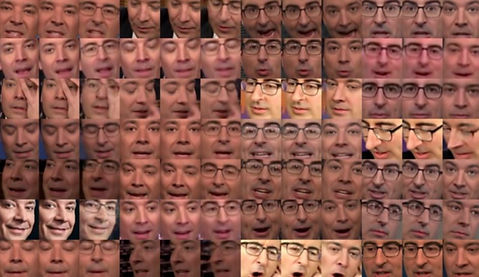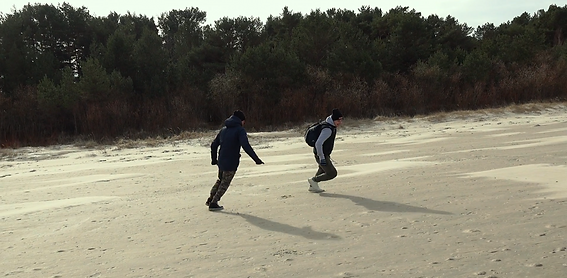About the Author

This website represents the culmination of my time at the University of Texas at Austin receiving my Masters in Media Studies.
I first began to take an interest in machine-human interactions and relationships in Dr. Sharon Strover's "Communication, Technology, and Culture" class, where I was first introduced to the digital influencer Lil Miquela. Miquela was the start of my thinking about the ways that we integrate machines and technology into our daily lives. In following this line of enquiry, I found myself contemplating the way that in taking a recuperative stance toward technology, and in looking at our images of machines and tech through a queer lens, can reveal new modes of being in the world. I found myself transfixed by the ways that these creations are frequently the backdrop that allow humans a way to imagine a different world and a different self. More often than not, these imaginings take on a distinctly counter-hegemonic sensibility.
Halfway through “Communication, Technology, and Culture” (Spring 2020), the COVID-19 pandemic forced us into remote online courses. I’m writing this section on the one-year anniversary of the World Health Organization declaring a worldwide pandemic. Since then, I’ve completed the majority of my Masters remotely.
Queer (Dis)information
The disinformative use of deepfake technology
It is essential that we recognize the deeply political stakes of strategic illegibility, particularly as it adheres to racialized and sexualized bodies that have for centuries developed tactics for the negotiation of visibility with respect to systems of power that would surveil, quantify, and police them.
-Gaboury, 153
For this section I will be pulling heavily from Jacob Gaboury’s “Becoming NULL” and his theorization of queer relations and technology. Throughout “Becoming NULL: Queer relations in the excluded middle,” Gaboury utilizes the concept of a NULL set in data relations between computers as a way to talk about queerness within “a normative system of relations” (153). Programming a NULL set “indicates the absence of any value whatsoever, such that linguistically it is not considered a value at all, but rather a “marker” that indicates a state of indeterminacy” (153). Null markers are illegible and the system will work hard to create data sets that exclude them. In their illegibility, Null markers create a “space for indeterminacy” (153) deep within the system they reside in.
People whose existence is something other than white, straight, and male are forced to occupy varying shades of risk simply by living in a world that privileges white, straight, and male. Gaboury comments on the ways that these individuals have developed tactics to negotiate both being seen and remaining unseen by power. Deepfakes allow for a strategic means to be both seen and hidden within the structures of the Chechen Republic and its surveillance. This is not accomplished from hiding but from making physical identity illegible.
I relate deepfakes to Gaboury’s NULL concept. Deepfakes allow the queer bodies in Welcome to Chechnya a “strategic illegibility (153). Illegible by the disciplining and normalizing powers of the state, the deepfakes deny the Chechen government access to the survivors’ bodies. They are able to maintain their agency within a system that wants them eradicated.

Example of data for the AI to map facial expressions
Queer (Dis)Information
The National Endowment for Democracy (The NED) defines disinformation as “politically motivated messaging designed explicitly to engender public cynicism, uncertainty, apath, distrust, and paranoia…” In taking this definition of “disinformation” I argue that the deepfake use in Welcome to Chechnya is an example of both “queer disinformation” and queered disinformation. Queer disinformation relates to the queer identities and bodies that are being protected by deepfake technology. Activists, such as Miguel Grisanti (pictured on the left), volunteered to have their facial features mapped in order to act as “human shields” for the survivors. The overlay of these volunteers’ faces are direct actions that keep queer bodies visible but hidden from the Chechen government. The volunteers' faces serve to take the singular light of Jeremy Bentham’s panopticon and diffuse it across multiple bodies at once—the survivor and the activist.
In moving from protection of bodies and into technology, queered disinformation (as mediated by the deepfakes) asks us to “imagine how queer theory and queer life might begin to reearticulate itself in ways that engage with and within technical systems” (Gaboury, 145). In conceptualizing queer disinformation, I hope to offer a viewpoint from inside the structure of disinformation itself. While I do believe that deepfakes signal the possibility of a terrifying future based on the inability to visually tell truth from construction, Welcome to Chechnya offers a counterexample where this blurring of visual truth and visual construction allows the survivors' narrative truth to come out.
Disinform: to dismiss an opponent’s claims or allegations, distort events to serve political purposes, distract from one’s own activities, and dismay those who might otherwise oppose one’s goals.
Click here for an example of a disinformation campaign and to learn how the Burmese government is persecuting Rohingya Muslims through Facebook.
Queer disinformation also allows for the spread of expression. As Benjamin Haber articulates in “The Queer Ontology of Digital Method,” new technologies “rearticulate embodiment and environment, queerness can more forcefully articulate a vision of indeterminacy that...is bent toward thoughtful interconnection and the perverse proliferation of pleasures and expressions” (161). The effect of being able to clearly see the emotions of the survivors endears us to them. They are present in an embodied way, much more present than had they been protected by a blur or animated (a tactic that was focus tested before the post-production of the documentary). The deepfakes serve to create layers of connection for the survivors. While they connect through the underground network of activists, the deepfakes allow them to connect with us.
Aside from distributing agency back to the survivors, deepfakes in Welcome to Chechnya are an example of queered disinformation. Chechnya uses a bottom-up formation to counter government control. The same tactics used in disinformation and spreading fear have been co-opted to protect at-risk bodies.

Maxim and his partner of 11 years play on the beach
Thinking Onward: What are some ways that users disinform data collection and surveillance today?
For a theoretical lens on this subject, I highly recommend Jacob Gaboury's "Becoming NULL: queer relations in the excluded middle." Click here for a PDF download of the article, or here to read it in a web browser.
Tweet your thoughts and include #QueerHMrelations
ADDENDUM: Myanmar's Disinformation Campaign against the Rohingya
Disinformation creates uncertainty and unrest through the spread of false information that targets an individual or group of people, usually members of minority groups. For example, the Rohingya Muslim community in Myanmar has been the target of a massive government-backed disinformation campaign, spread through edited photos and videos depicting the Rohingya (falsely) committing atrocities. This campaign has managed to sway public opinion to such an extent that whole Rohingya villages have been razed by the government.





